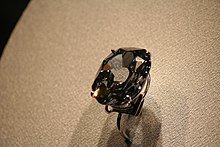Wittelsbach-Graff Diamond

Wittelsbach-Graff Diamond, on display at the National Museum of Natural History
|
|
| Weight | 31.06 carats (6.212 g) |
|---|---|
| Color | Fancy Deep Blue |
| Cut | Antique oval stellar brilliant |
| Country of origin | India |
| Mine of origin | Kollur Mine, Guntur District |
| Discovered | Mid-1600s |
| Original owner | Philip IV of Spain |
| Owner | Sheikh Hamad bin Khalifa Al Thani, Father Emir of Qatar |
| Estimated value | US$80 million (June 2011) |
The Wittelsbach-Graff Diamond is a 31.06-carat (6.212 g) deep-blue diamond with internally flawless clarity. Laurence Graff purchased the Wittelsbach Diamond in 2008 for £16.4 million. In 2010, Graff revealed he had had the diamond cut by three diamond cutters to remove flaws. The diamond was now more than 4 carats (800 mg) lighter and was renamed the Wittelsbach-Graff Diamond. There is controversy, as critics claim the recutting has so altered the diamond as to make it unrecognisable, compromising its historical integrity.
The original Wittelsbach Diamond, also known as Der Blaue Wittelsbacher, was a 35.56-carat (7.112 g) fancy, deep, greyish-blue diamond with VS2 clarity that had been part of both the Austrian and the Bavarian Crown jewels.
Its colour and clarity had been compared to the Hope Diamond. The diamond had measured 24.40 millimetres (0.961 in) in diameter and 8.29 millimetres (0.326 in) in depth. It had 82 facets arranged in an atypical pattern. The star facets on the crown were vertically split, and the pavilion had sixteen needle-like facets arranged in pairs, pointing outward from the culet facet.
The diamond originates from the Kollur mines of Guntur District in Andhra Pradesh. The story that King Philip IV of Spain purchased the jewel and included it in the dowry of his teenage daughter, Margaret Teresa, in 1664 is apocryphal. The first time the diamond was mentioned is about fifty years later when it was already in Vienna. It was in the possession of the Habsburg family and came to Munich when, in 1722, Maria Amalia married Charles of Bavaria, a member of the Wittelsbach family.
In 1745, the Wittelsbach Diamond was first mounted on the Bavarian Elector's Order of the Golden Fleece. When Maximilian IV Joseph von Wittelsbach became the first King of Bavaria in 1806, he commissioned a royal crown that prominently displayed the diamond. Until 1918, the jewel remained on top of the Bavarian crown. It was seen last in public at Ludwig III of Bavaria's funeral in 1921.
...
Wikipedia
